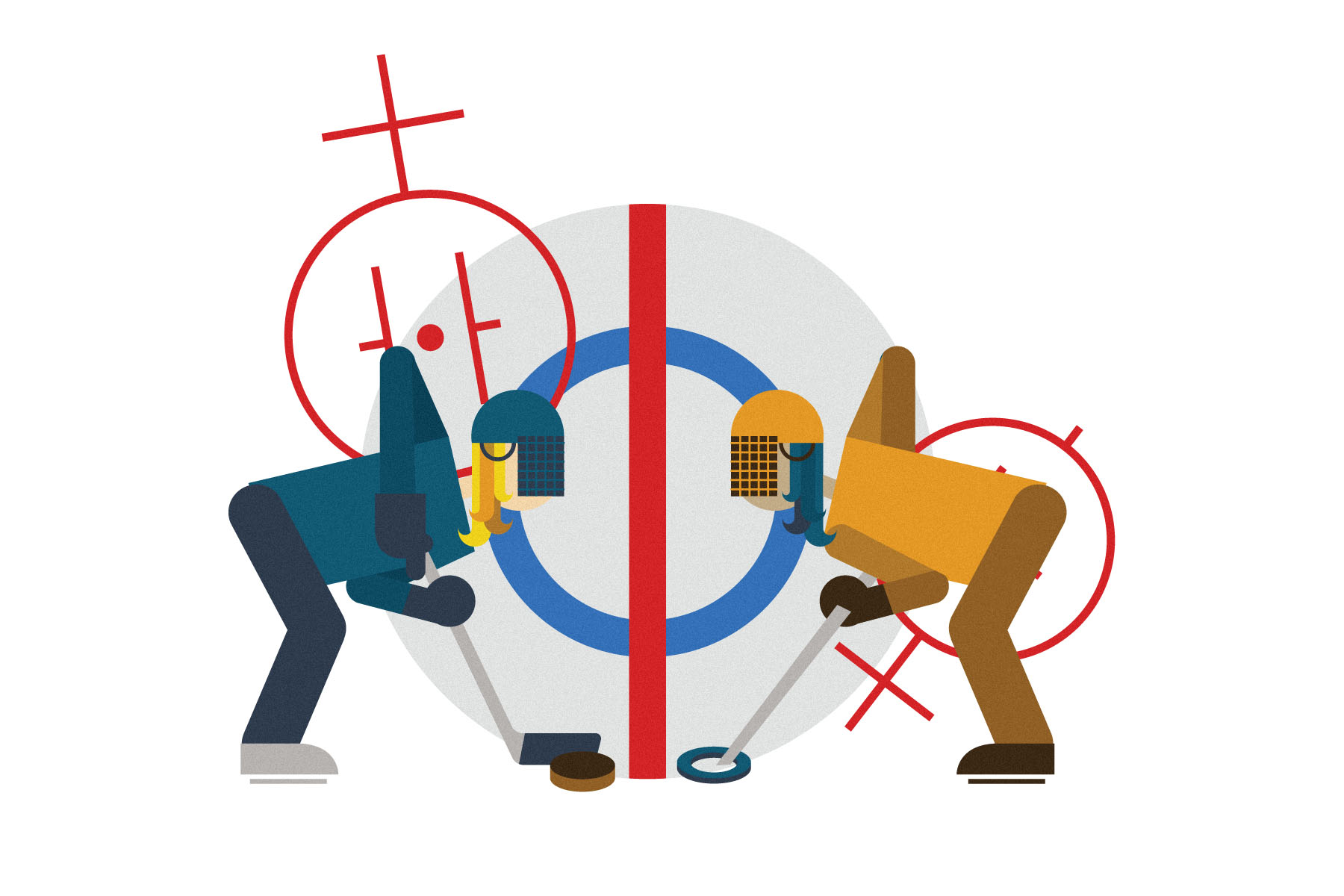When Canadians watch hockey today, we are watching men.
Riddled with patriarchal language, hockey—and ringette— was created with men in mind. This is evidenced by the names of penalties such as “too many men,” and terms such as “defencemen.”
But where are all the women?
Canadians began playing hockey in the 1880s. Women began playing as early as 1891 in Ottawa. Dressed in long wool skirts and figure skates, women hockey players were accepted for a short time as equals on the ice in certain provinces – namely Saskatchewan.
This did not last, as doctors warned women of the “dangers of athletic exertion,” and dissent against women playing hockey grew. During the 1920s and ’30s, women’s hockey, which at the time involved body checking and slashing, received more publicity than the decades that followed. As Joanna Avery and Julie Stevens note in the book Too Many Men on the Ice, during this time period, some women were discouraged or forbidden from the sport altogether by their husbands.
During the Second World War, women’s hockey took a backseat to the men’s game. While women already received the bottom of the barrel with regards to ice time and equipment, now athletic funds for women were being cut and entire teams collapsed. Men’s hockey was seen to be more profitable, with the National Hockey League being a case in point.
In the 1960s, women’s hockey experienced a restoration at the university level. At Queen’s University in Kingston, Ontario, the women played a physical, aggressive game, in spite of a rule prohibiting body checking.
Associations and individuals lobbied for women’s hockey. In 1974, a player on the Queen’s University team requested in vain that the American Hockey Association include women’s hockey as an Olympic sport. The Ontario Women’s Hockey Association, started in 1975, lobbied for inclusion in the Ontario Winter Games, the national championships, and the world championships.
Despite these efforts, women could not access hockey the way men could. The Canadian Hockey Association didn’t recognize women’s hockey until 1982 after the inception of the National Female Council. A 1992 National Collegiate Athletic Association study examined gender equity in ice hockey. The study revealed that males received 69.6 per cent of scholarship money. The recruiting budget received was 82.8 per cent for males, and 17.2 per cent for females. The media also largely ignored female hockey, at least in contrast to the attention men’s hockey received.
Women lacked access to the sport; there were “fewer psychological and material rewards for women athletes and less access to status and prestige,” according to M. Ann Hall and Dorothy A. Richardson in the book Fair Ball: Towards Sex Equality in Canadian Sport.
Sports involving body contact were forbidden to women in the early 1900s, a ban rooted in the notion of women as dainty beings who cannot risk damaging their reproductive organs and consequently abandoning their compulsory maternal role. It turns out, though, that female reproductive organs are well-protected. As highlighted in Fair Ball, “the uterus is surrounded in an aqueous material that absorbs and distributes forces so well that injury is highly unlikely.”
Females were left out from hockey partly because it served as a training ground for professional leagues, and there was and still is no professional league for women. Other reasons included the still pervasive belief that women are physically inferior to men. Fair Ball asks, “Are women athletes inferior for biological reasons or because they haven’t benefited over the years from the same systemic and rigorous training as men?”
Another harmful idea that discourages women from playing hockey is that women shouldn’t have muscles because muscles are masculine traits; women should be slender and attractive, and bearing traditionally masculine traits such as muscles makes women undesirable to men. An aggressive sport such as hockey risks women’s femininity. There is also a stigma for aggressive, strong women: all successful female athletes are lesbians. This belief serves to prevent women from playing hockey due to the homophobic harassment that ensues.
Elizabeth Etue and Megan K. Williams write in On the Edge: Women Making Hockey History, “Harassment, inadequate access to ice time, underfunding and the underrepresentation of women on organizational bodies all attest to a sports world that promotes and guards the aspirations of some boys and views the aspirations of girls as a threat.”
The problem of females entering the traditionally male domain of aggression and violence (ie. ice hockey) was addressed through the creation of sports made specifically for females.
Enter: ringette, which is similar to hockey but is not a contact sport – an ideal arena for girls and women to uphold their “feminine charm.”
Ringette was invented in 1963 by Sam Jacks in North Bay, Ontario, who found that girls were not playing hockey and needed an ice sport as well. In the beginning, much like Eve was allegedly created out of Adam’s rib, ringette sticks were made from hockey sticks with the blade removed.
In this safer environment, female athletes could thrive. Ringette quickly grew; in 1983, there were over 14,500 ringette players. According to On the Edge, in that same year, “the number of players registered in women’s hockey was a mere 5,379, less than 40 per cent of ringette’s numbers.” Today there are over 80,000 girls playing hockey.
When women’s hockey banned body checking in 1986, some ringette players moved on to hockey. In spite of this, the only year ringette registration actually decreased was in 1998, most likely due to women’s hockey becoming an Olympic sport for the first time. There are currently more than 27,000 ringette players in Canada.
The levels of ringette play in Canada were divided into Bunny, Novice, Petite, Tween, Junior, Belle, and Open. These categories, as noted in On the Edge, “leave no room for confusion about one’s sexual identity.”
The names of these levels have recently been changed to U8 (under eight), U10, U12, U14, U16, U19, and 18+, perhaps to abandon the notion of females as delicate creatures. Other aspects of ringette have changed as well. As Hayley Mick writes in the Globe and Mail, “Today’s ringette is not your grandmother’s ringette. Modern ringette is stocked with good Canadian stuff like the occasional busted rib.” Adding a shot clock, which gives the team with ring possession only 30 seconds to shoot, for higher levels has also quickened the game.
Canadian Olympic gold medallist Hayley Wickenheiser has seen career success playing in a professional men’s league, and women’s hockey has also come a long way, but, as noted earlier, there is still no professional women’s league. So while men have leagues such as the NHL to aspire to, women typically cannot make a living playing hockey. National Hockey League commissioner Gary Bettman said a women’s professional hockey league doesn’t make business sense, yet.
Ringette and women’s hockey are still entrenched in gender norms. While boys are technically allowed to play ringette until age 12, and you may see the occasional male goalie in higher levels, you would be more than shocked to see a boy playing the sport. Ringette is still seen as a female sport and, unfortunately, therefore a lesser sport.
While boys don’t need access to ringette, as they have the privilege of men’s hockey, the problem with gendering sports is that it causes a divide and serves to exclude the marginalized group. If a boy or man were to play ringette, they would undoubtedly be ridiculed and viewed as less of a man – because ringette is supposed to be free of all “masculine” traits.
It’s only been 17 years since women began playing hockey in the Olympics. Progress takes time – time for competition to build, more players to join the game, and for sexism to dissipate. It’s also been 52 years since ringette was invented. Hockey and ringette are increasingly accessible to women and girls who want to play aggressively on the ice, but for equity to be achieved, we need to start with a successful professional women’s hockey league so that women can make a living playing the sport they love as well.
Perhaps if hitting and fighting were incorporated into women’s hockey it would be more entertaining and profitable. The current rule in the Olympics is that while only some men require partial visors, women must wear full face masks. This rule would need to be changed in order for women’s hockey to be taken seriously – or fighting banned from and face masks made compulsory for men’s hockey. Some argue that women’s hockey is faster than men’s because it is exempt from fighting and hitting.
In order for these rules to change, society’s ideas about weak, fragile women will need to evolve.





